Key Points:
- A Wall-hugging False Ceiling: You can have a false ceiling that hugs your walls, and you can either have the same height or different height ceilings. The wall-hugging false ceiling is great for small areas and gives a room an illusion of higher ceilings.
- The Chicken Coop Ceiling: This is one of the most popular false ceiling ideas. You can put chickens on top of it, which will add to your home’s value; chicken eggs are a plus.
- The Mirror Ceiling: The idea is to have a mirror on top of your false ceiling; you can look at your reflection now and then. This idea will also bring a simple element to your living room.
- The Invisible Ceiling: You can have an invisible false ceiling that will make your room look larger than it is. The idea is to have the same height illusion on all sides of your walls.
- Floating Ceilings: This is one of the most exciting ideas we’ve come across in this post. You take this idea one step further by floating pieces of furniture on top of the false ceilings. It creates another dimension for your living area with different heights. So if you are planning on doing something similar, consider going with floating pieces not to look too overwhelming.
- The Box Ceiling: This box ceiling will be great for those with small apartments with lots of space inside. It’s like a mini closet; it offers plenty of room to store stuff, or as if you were using wall shelves instead of actual shelves.
You are mistaken if you think the living room ceiling would not be gazed upon. It holds an elegant aspect of the living space, especially when done cleverly.
A false ceiling does various jobs, such as insulation, decoration, or camouflaging the odd building ducts. Known as the fifth wall, it can help you conserve energy while giving a distinctive look to the space.
The difficulties in designing a false ceiling may vary depending on your living room structural plan. Believe it or not, your plain ceiling is just like any wall in your home.
Here are 10 creative false ceilings for your living room (small/regular size) you could address and copy to get them right by Simphome.com.

🔊10 Creative False Ceilings for your Living Room Video
List Entries:
Which false ceiling is best for the living room?
Instructions:
- Step 1: Find the right materials
There are no right or wrong materials to use in making false ceilings. It all depends on how you want your room to look. Maybe you need a ceiling that sits flush with the walls, and maybe you need a ceiling that gives it more height. The first thing is to decide how high you want your ceiling to be, and then you should think of the material used in its construction.
The key thing is to find an item that fits the height of your room and with ample space for lighting fixtures, vents, and other utilities. And always remember not to put anything inside your false ceiling that will interfere with its structure or airflow. - Step 2: Prepare your ceiling
Using a tape measure, first determine the length of your ceiling. Make sure you measure extra up and down the wall to account for possible obstructions and the height of your window. Then mark off how much material you will need. It is also important to know if there will be a stud on the middle part that supports it, so make sure that you plan accordingly. - Step 3: Cut it
For good measure, cut out three pieces at each end and one in the center with about 1/4 inch gap between them for ventilation. You’ll need to mount these pieces in place using screws or nails. (It’s best to use nails just because they have more grip. If you use screws, however, make sure that you are using appropriate-sized ones with no sharp edges.) - Step 4: Install the middle piece
You need to paint the middle portion of your ceiling first before installing the middle piece. Then, take your level and mark out where it will be mounted. Ensure that you are at least above any possible obstructions as you will lay all the materials on top. Finally, screw or nail the bottom piece in place and then do the same procedure for the top piece. Make sure to place a plastic or paper under it if there is a chance of water getting inside.
Is a false ceiling good for the living room?
The answer will depend on the kind of room you have. A false ceiling can be very helpful in making the room look bigger without increasing its dimensions. It is also great for creating an illusion of space from which people can see through it to the outside.
In addition, they are easy to clean and do not require additional services or installation costs. Thus, they are perfect for small rooms where there are high ceilings.
General Instructions if you want to build your first false ceiling:
- Step 1: Measure your space
First, you need to measure the space in your room to buy the right size of false ceiling. Supposing you want to install a ceiling with a 1-inch gap all around, then measure the width of your space and add 12 inches. Then, add 4 inches more if the height (distance between the floor and ceiling) is less than 12 feet. - Step 2: Buy materials
Next, you should buy the required materials for false ceilings. You just need some boxes or pieces of steel mesh evenly placed on top of each other. You must put these materials together in a way that they form a box. You must also include some indoor-outdoor paint for protection from harsh weather conditions and UV rays. - Step 3: Paint, install and attach light fixtures.
Paint the ceiling using a roller, and then install your lights. Make sure everything looks clean before you turn on the lights. The next step is to attach the ceiling to the wall studs using screws. - Step 4: Hang the ceiling
Lastly, hang the ceiling using nails or screws, if needed.
Is a false ceiling long?
Answer: No, there are many different sizes for the ceilings. They range from 6 inches to 48 inches. For small to regular size rooms, the range is from 8-20 inches. You can search in your local hardware store or online for a variety of prices and styles to suit any budget and taste. The article will give some ideas on some types of false ceilings that you might consider buying, along with measurements, descriptions, tips on installation, uses, and more information about each one!
Is the false ceiling outdated?
The answer will depend on the kind of room in your living space.
Which type of false ceiling is best?
You can choose the false ceiling style based on the look you want to achieve—many options, including gypsum, fiberboard, wooden panels, and metal. You can paint a false ceiling using a roller and a paint sprayer.
The best choice will depend on your space and your type of room. For example, if you want to replace a ceiling in a kitchen, it is best to use plywood or MDF material that is lightweight and easy to carry. However, if you want to make your living room look bigger but do not want to increase its dimensions, you can use a metal mesh with different colors and designs.
How to maintain a false ceiling properly?
Instructions:
- Step 1: Clean the ceiling with a wet vacuum
First, remove the dust by using a vacuum cleaner. Use a brush or vacuum attachment to ensure no - dust particles are left on the ceiling.
Step 2: Check for any cracks or holes.
Next, check the ceiling for any cracks or holes in it. Make sure that you check every part of it. If you find them in your ceiling, you must fix them immediately as they will be very dangerous when left untreated. - Step 3: Remove debris using a wet sponge
Next, take a wet sponge and start cleaning off any debris to keep the house clean and the air fresh. This step is important to make your living space look clean and polished. - Step 4: Seal the ceiling with a white paint
You can now seal the ceiling with white paint to keep it from getting dirty. This idea will also help you maintain a healthy and clean environment. - Step 5: Use a roller to apply the paint evenly to the ceiling
Lastly, you should apply the paint using a roller to cover all parts of the false ceiling. You should also use a paint sprayer for this step if the ceiling is too big.
After that, wait for a few hours or overnight so that the paint can dry completely.
Can a false ceiling be painted?
Answer: A false ceiling can be painted to change its appearance. This idea is especially helpful if you are not happy with the original look of your false ceiling or want to change the room’s color scheme. The painting will help improve its appeal and give a fresh new look to your living space.
Which type of paint should you use?
There are many types of paints available today, but latex enamel is one that is highly recommended for covering a false ceiling. It has metallic, non-metallic, and synthetic forms available in different colors and design options. You should choose the paint according to your needs and requirements for a flawless finish on your ceiling.
Which putty is best for the false ceiling?
Answer: Many different putties and tapes are available for a false ceiling. Each material has its strength and thus is suited for a different purpose. Thus, you should look for the best suitable one for your living space.
What is the difference between plasterboard and gypsum?
Gypsum or drywall ceiling will come pre-painted while you need to paint plasterboard after it is installed. However, both will have almost the same thickness as these two materials usually vary by 1/2 inch or less. You can install either one, depending on your preference and needs.
Which paint is used for the false ceiling?
Answer: There are many different types of paints available in the market today. However, latex enamel is the best paint that you can use for covering a false ceiling. It has metallic, non-metallic, and synthetic forms available in different colors and design options. You should choose the paint according to your needs and requirements for a flawless finish on your ceiling.
What is a gypsum false ceiling?
Answer: Gypsum or drywall ceiling will come pre-painted while you need to paint plasterboard after it is installed. However, both will have almost the same thickness as these two materials usually vary by 1/2 inch or less. You can install either one, depending on your preference and needs.
Can you paint a false ceiling yourself?
Answer: Yes, you can paint a false ceiling yourself. There are many different types of paints available in the market today, and they are designed to ensure that they are perfect for painting all types of ceilings like wood, gypsum, etc. You should choose the paint according to your needs and requirements for a flawless finish on your ceiling.
10. Find Your Design and Texture
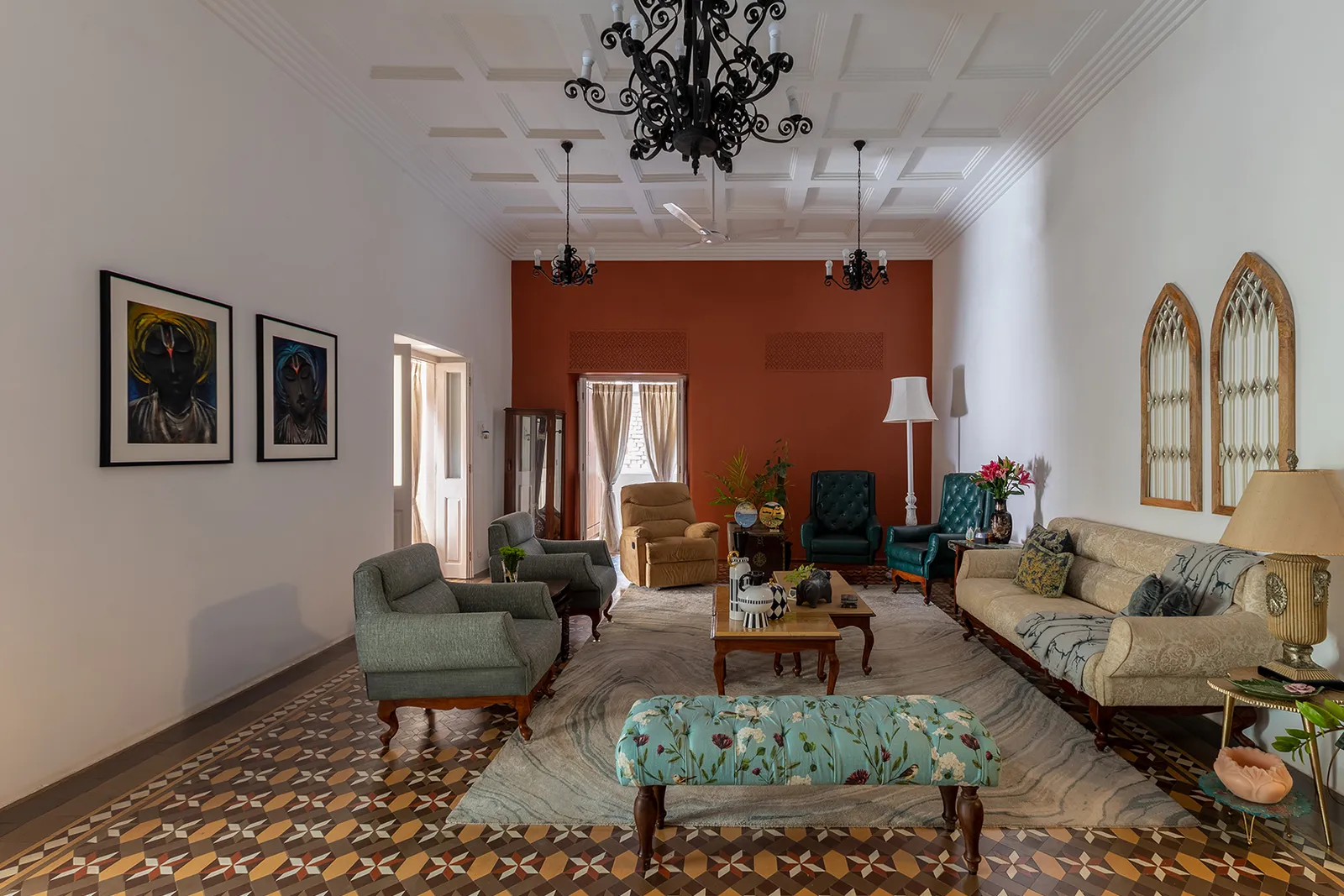 A room’s architectural design will affect a ceiling concept. Most modern homes work nicely with geometrical curves, while traditional homes are more compatible with moldings and columns.
A room’s architectural design will affect a ceiling concept. Most modern homes work nicely with geometrical curves, while traditional homes are more compatible with moldings and columns.
However, there are two basic designs to decide how you would change your plain ceiling into an interesting one. The first is a flat ceiling, the most popular false ceiling style to conceal building service lines while accommodating the recessed lights. The second is a layered ceiling that hoards different levels of moldings to create a molded look.
Once you have picked the design, let’s move to the texture. Adding a tray of light can enhance the ambient luster and visual drama. You can also improve the look by attaching a lattice screen or carved wooden slats to create a dramatic ceiling.
The ceiling can be the central feature in your living room when you combine it with beadworks, artwork, or faux finishes. All three enrich the look and act as a focal point of your living room interior.
9. Choose The Best Material
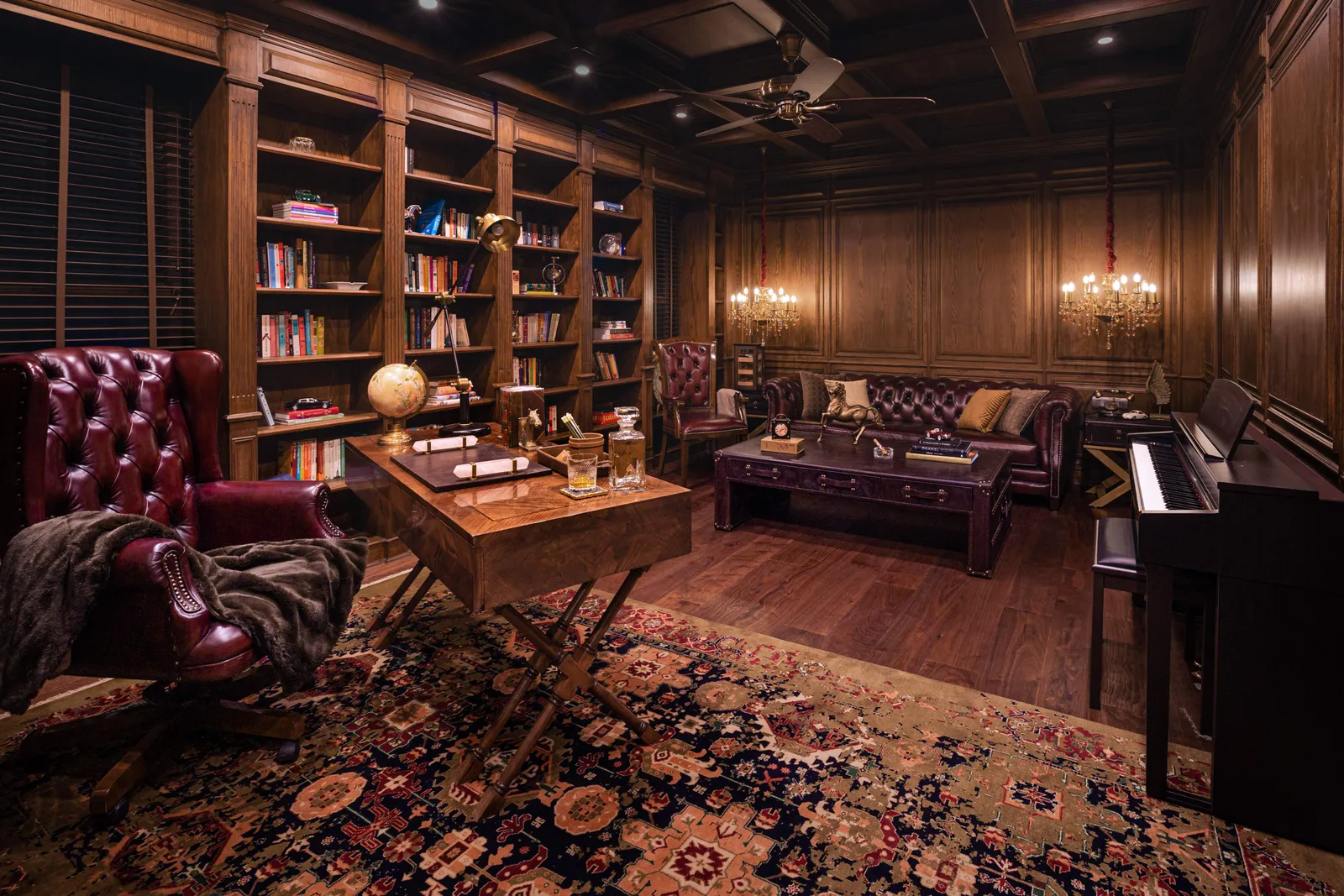 After you decide on the design of your false ceiling, choose the materials that are most suitable for your building.
After you decide on the design of your false ceiling, choose the materials that are most suitable for your building.
There are several options available. First, if you want a ready-to-install false ceiling, you could try gypsum. It is a low-cost material and easy to install. It hangs off the ceiling with an iron or wooden framework. The material is flexible to create different bends and shapes. Moreover, it is the best option if you want a colored false ceiling.
The second is Plaster of Paris (POP), which is available in a powdered form. So, you have to mix it on-site to create any shapes you want. POP is known for its insulating properties that hold any weather conditions. However, in a period of time, you would find it developing cracks.
The third is a wooden false ceiling that can be a bold choice for you. The natural texture infuses warmth and contemporary appeal into the space. It works best in a cold climate country. Although it is easy to install and sophisticated, you will spend more on the cost and maintenance.
The fourth is PVC. Although it is more appropriate for moisture-laden areas such as the bathroom, it can cover up your living room and give you a superior finish. Glossy white PVC can brighten your entire space.
8. Know that Size and Height Determine Your Design
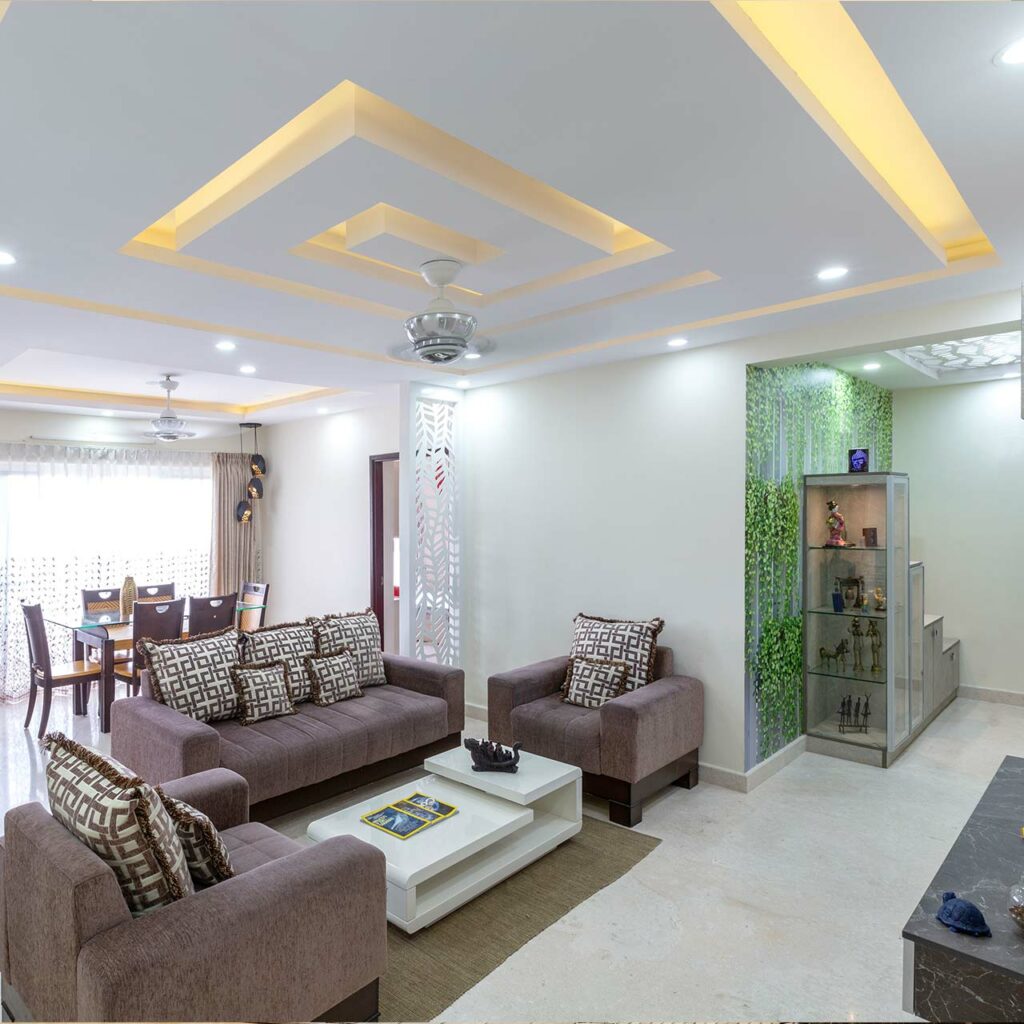 To ensure you would not go wrong with the proportions and dimensions of your false ceiling, you should know your living room’s size. The living room usually has more space than other rooms in the house. So, it needs more niches and a variety of lighting. If you have a low ceiling, don’t make it tighter by adding a false ceiling. Instead, you could play with paints or other textural elements. You take the benefit if you have a high ceiling because you can experiment with any design that fits your home.
To ensure you would not go wrong with the proportions and dimensions of your false ceiling, you should know your living room’s size. The living room usually has more space than other rooms in the house. So, it needs more niches and a variety of lighting. If you have a low ceiling, don’t make it tighter by adding a false ceiling. Instead, you could play with paints or other textural elements. You take the benefit if you have a high ceiling because you can experiment with any design that fits your home.
7. The Simple and Functional Concept
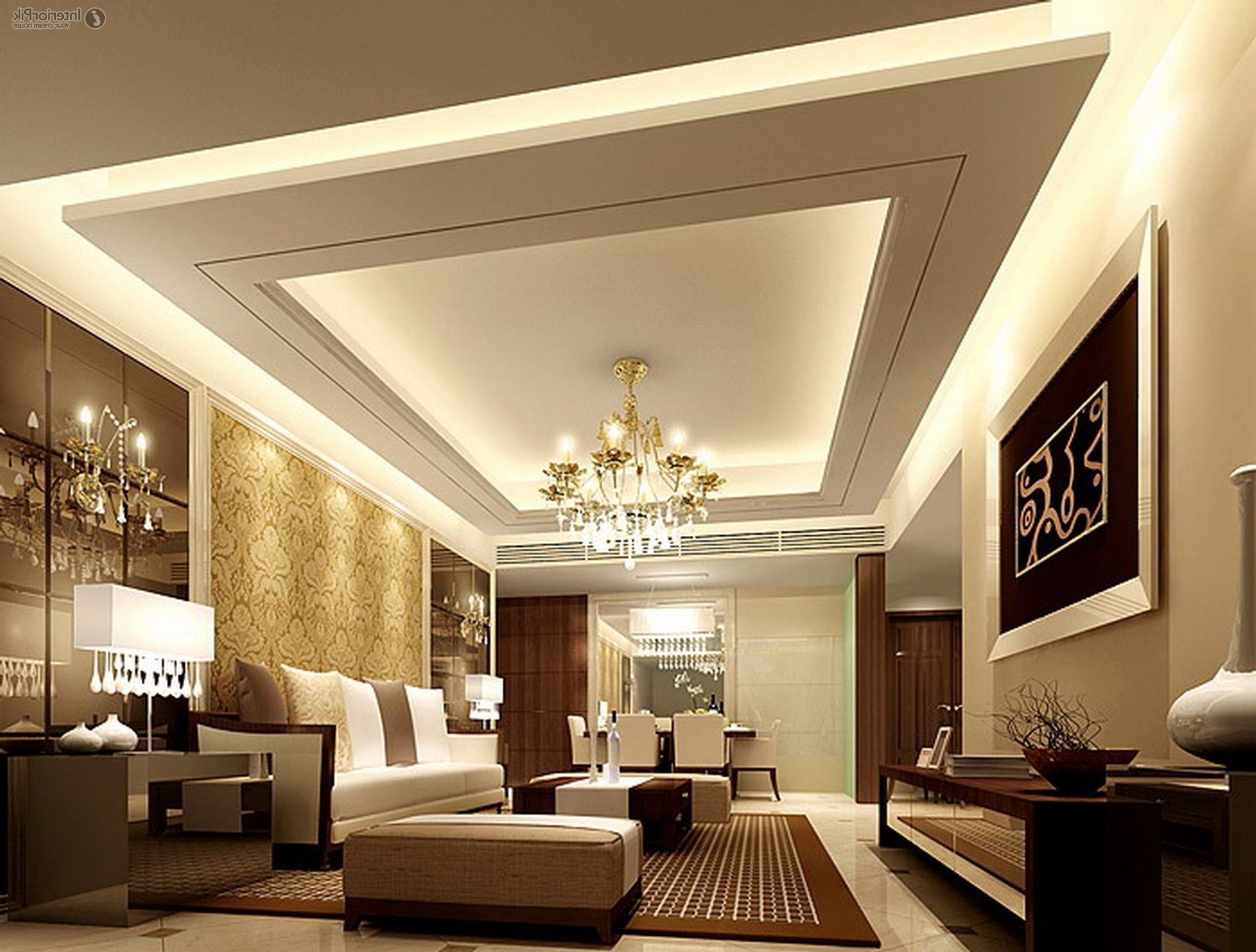 If you don’t like loud design, opt for this simple one. But you have to choose the style before planning it. The size and height of your living room also determine what design you could incorporate.
If you don’t like loud design, opt for this simple one. But you have to choose the style before planning it. The size and height of your living room also determine what design you could incorporate.
Cove designs are the safest best you can take. They are easy to implement and bring a warm and cozy feeling into the room.
Installing spotlights in a straight line will make your room visually larger. To ensure that the lights are not too glaring and sharp, you can have them installed on the sides.
A coffered false ceiling can also provide the space with a rich look yet simple. Another trend is tray false ceiling, which focuses on providing enough light into the room, so you don’t need lighting fixtures covering the walls.
6. Re-Arrange the Lighting Position
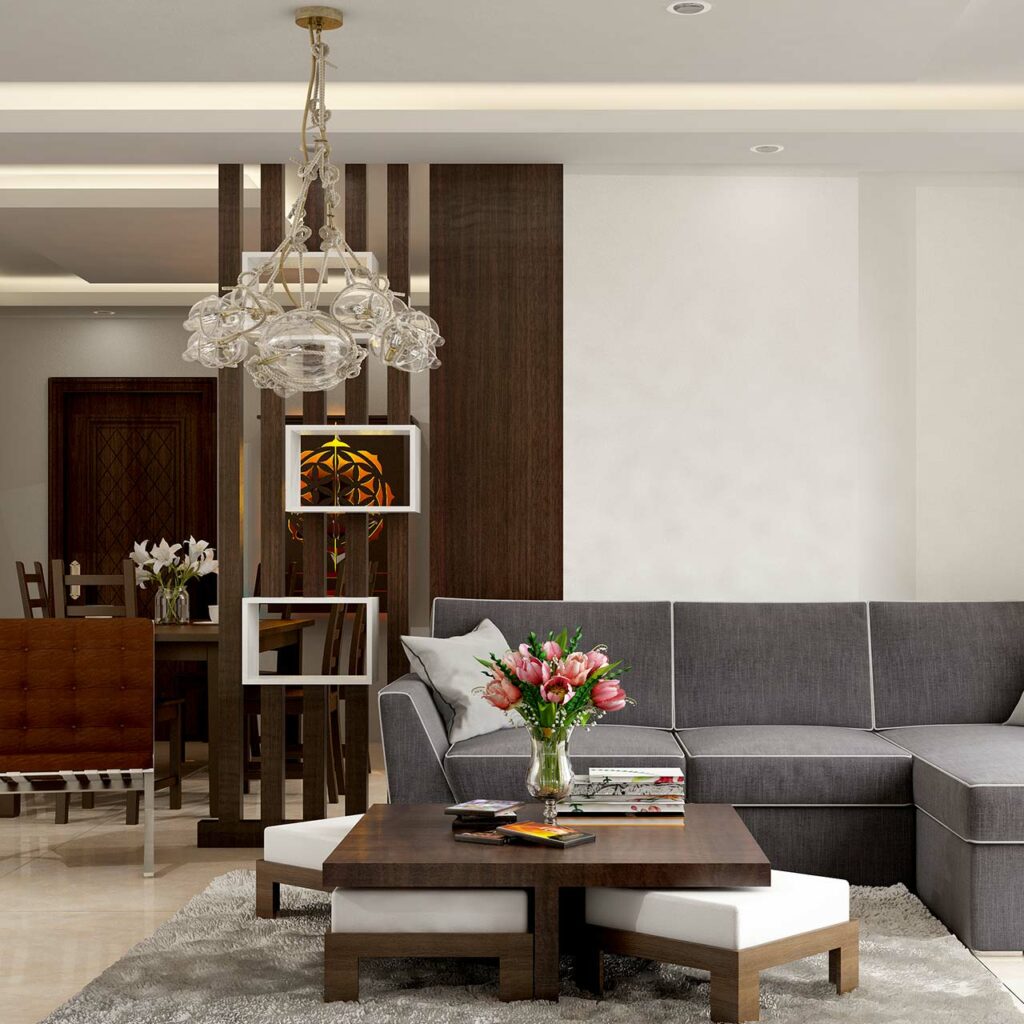
You can do with the POP ceiling for a small living room and mix some spots of fixtures and cove lighting. You could try something different by incorporating a skylight into your living room’s false ceiling. Placing it at a strategic point will let in plenty of natural light. Moreover, skylights come in many shapes and textures. Affixing them with frosted or plain glass will add a different dimension to your living room.
5. Single vs. Multi-Layered False Ceiling
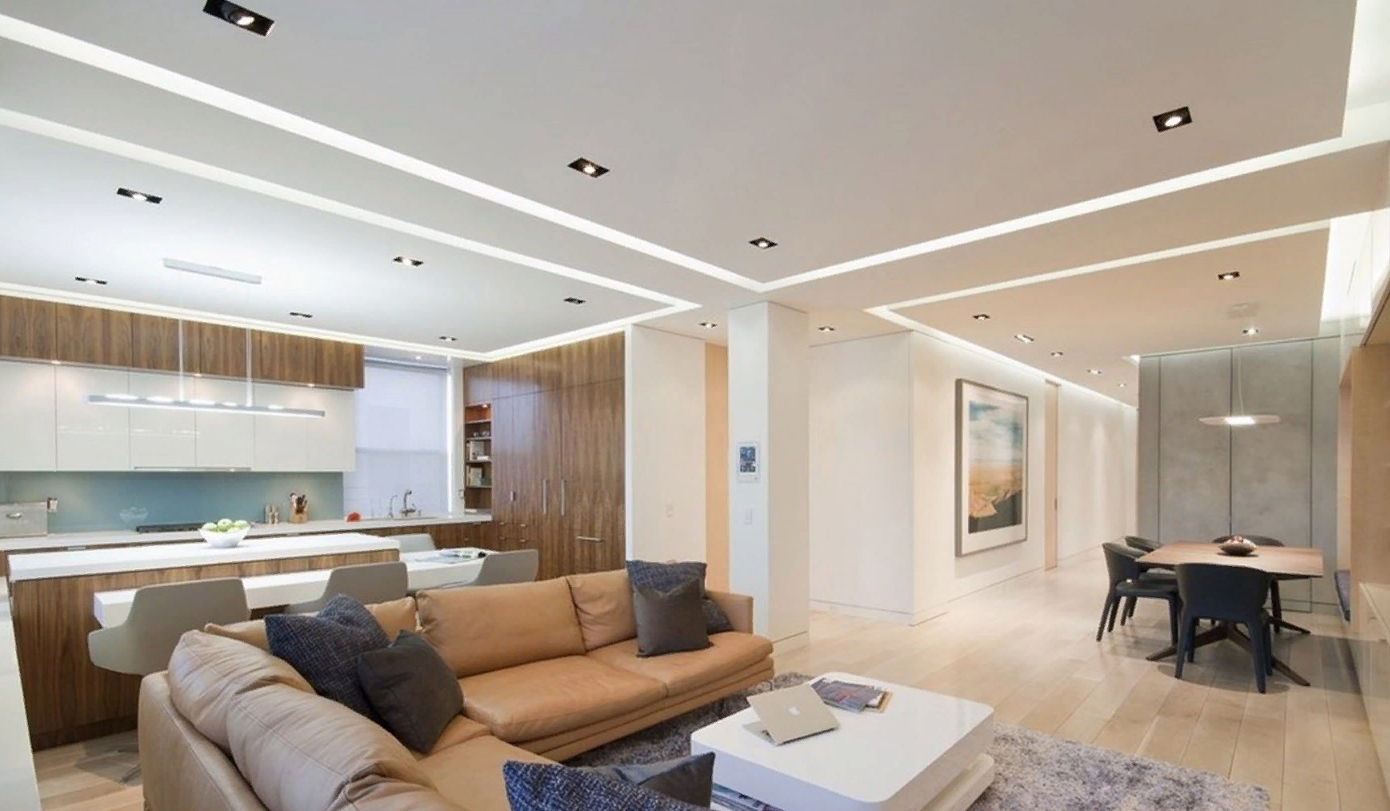 The single-layer ceiling will be a good choice if you want to style the ceiling without overwhelming the space. It is ideal and perfect for a small living room, especially if you have a minimalist interior.
The single-layer ceiling will be a good choice if you want to style the ceiling without overwhelming the space. It is ideal and perfect for a small living room, especially if you have a minimalist interior.
To add more character to the ceiling, apply some color, shapes, textures, or lighting. However, layering it can create an illusion of a bigger room. Just make sure you already measure the height of the wall.
If you have a bigger space, you could try layering the false ceiling to create a feeling of grandeur. Cove style with LED installation and colored borders does wonders to the entire look. Further, layered tray ceilings will create a three-dimensional effect without extra embellishment.
4. The Canopy False Ceiling Design
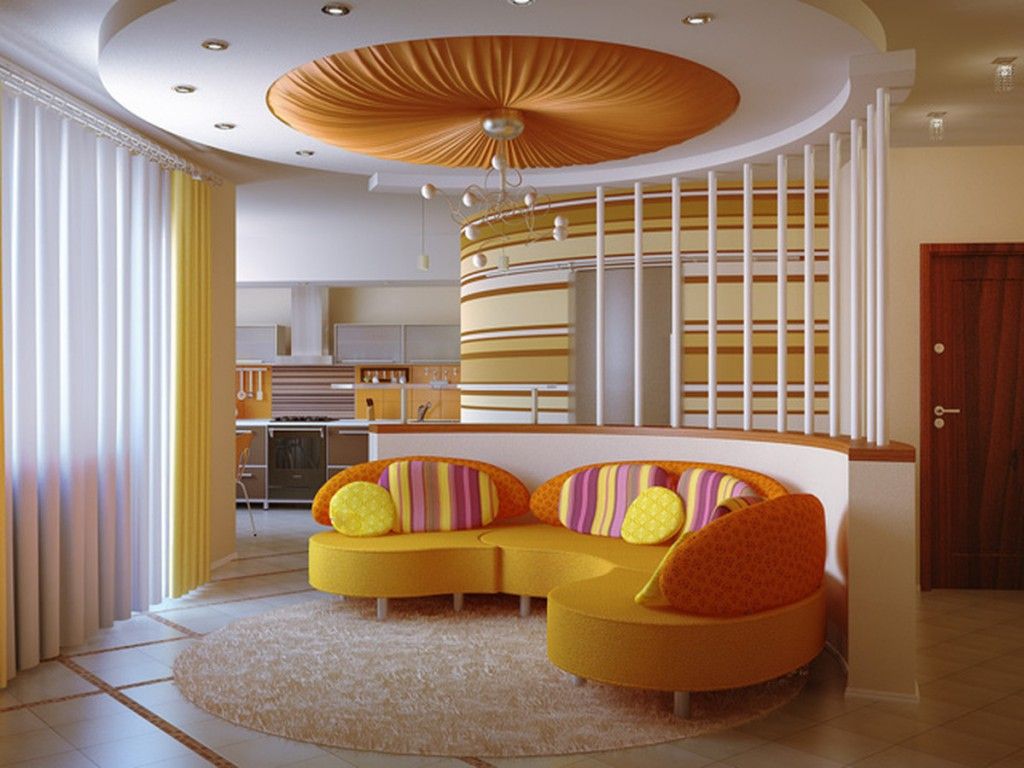 A canopy can be a dramatic view of a room. It creates a warm and intimate feeling. Although people usually install canopies in a bedroom, you can use them differently.
A canopy can be a dramatic view of a room. It creates a warm and intimate feeling. Although people usually install canopies in a bedroom, you can use them differently.
First, measure the light fixtures so your fabric will not cover them. Second, screw hoop around the fixtures. You can paint it to match the fabric before installing it. Third, cut the fabric. Don’t cut it too long, though. Otherwise, it will hang too low. Fourth, sew the fabric to the hoop. Last, install the canopy to the ceiling.
3. Wallpapered False Ceiling
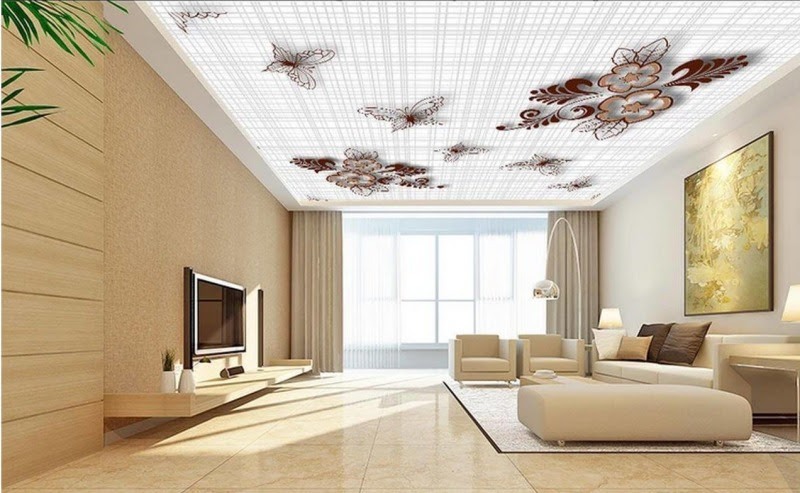 If you think wallpapers are only for walls, you are wrong. You can have it applied to the ceiling as well. But you have to select them carefully, so they will not hamper the room’s look. However, if chosen wisely, your living room will look spectacular. Light-colored wallpapers will virtually add volume to the room.
If you think wallpapers are only for walls, you are wrong. You can have it applied to the ceiling as well. But you have to select them carefully, so they will not hamper the room’s look. However, if chosen wisely, your living room will look spectacular. Light-colored wallpapers will virtually add volume to the room.
Todays’ wallpapers have many types and designs. There are three basic types: pre-pasted wallpaper with an adhesive backing that needed a damp sponge to activate the glue.
Second, paste-the-wall wallpaper, which needs glue before installing it to the wall. Third, peel-and-stick wallpaper, which is reusable.
2. Cove and Drop False Ceiling
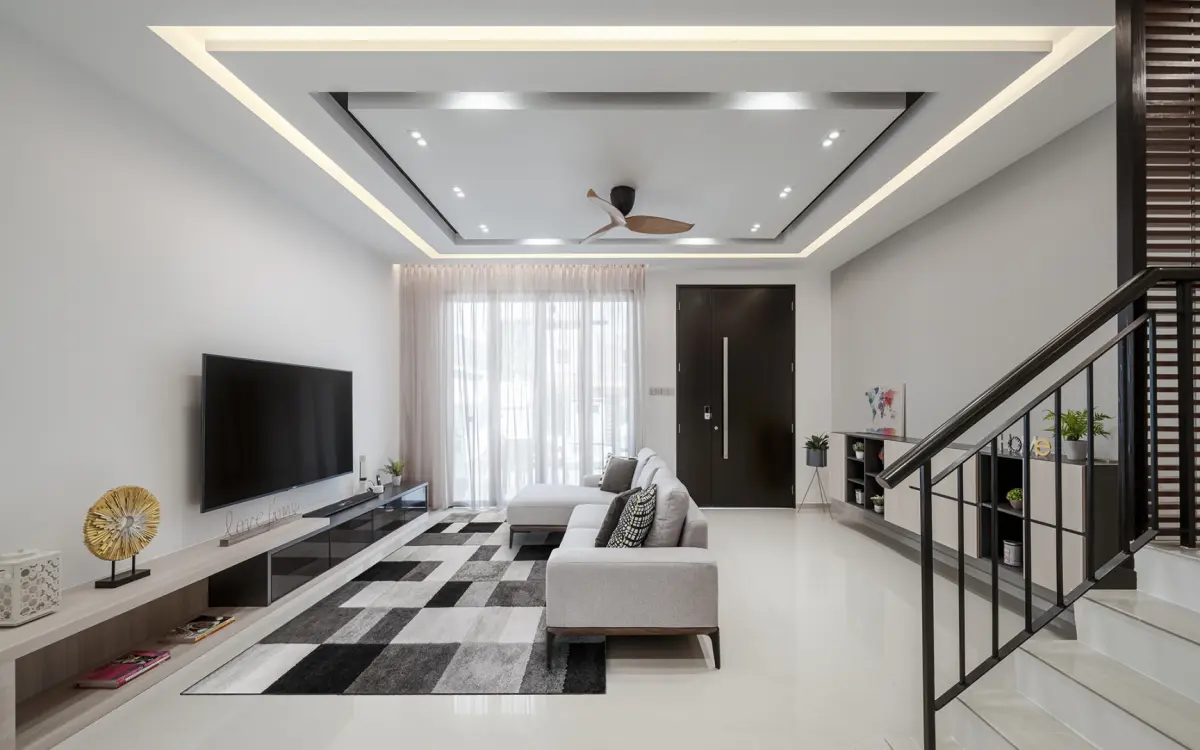 As the most popular false ceiling design, the cove ceiling covers the space in a straight, rectangular slab. This design helps you save money because it has to disperse light ability. So, you don’t need to add more lighting fixtures. While the cove ceiling uses the edge for the lighting, the dropped ceiling uses the center of the existing one. This design is directly supported by the upper ceiling using metal frames. For this reason, people also call it suspended ceilings.
As the most popular false ceiling design, the cove ceiling covers the space in a straight, rectangular slab. This design helps you save money because it has to disperse light ability. So, you don’t need to add more lighting fixtures. While the cove ceiling uses the edge for the lighting, the dropped ceiling uses the center of the existing one. This design is directly supported by the upper ceiling using metal frames. For this reason, people also call it suspended ceilings.
Lastly, Number 1. Geometric False Ceiling
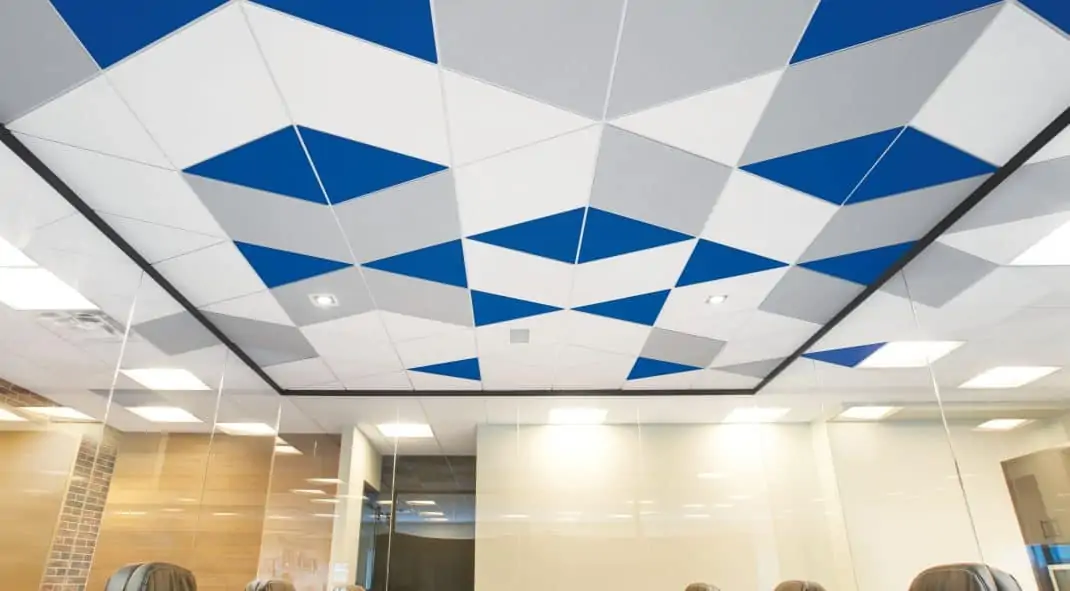 Geometric patterns are the hallmark of modern home interior designs. For ceiling makeovers, creating geometric style can be achieved by installing wallpaper, painting, or adding stencils.
Geometric patterns are the hallmark of modern home interior designs. For ceiling makeovers, creating geometric style can be achieved by installing wallpaper, painting, or adding stencils.
First, decide what patterns you will apply to the surface. Find patterns on the internet for references and pick one that complements your living room design. Next, consult the color chart so your color choice will not hamper the design. Then, sketch the ceiling. Finally, you can take your brush and start painting.
The geometric patterns that you choose will define your living room character. Triangles make the room feel dynamic and energized. The hexagon can achieve structure and serenity. However, if you like simple patterns, try squares or circles in repetition to create a balance geometric pattern.
A false ceiling can alter the look of your living room interior design. A good selection of styles leaves you with a bright and impressive space. And these 10 creative false ceilings for the living room may give you some inspiration. Now, unleash your imagination and creativity to create one.
Conclusion:
We hope this article inspired you to understand the importance of why you should have a false ceiling in your house. A false ceiling will not just give you an open and fresh look but also keep your entire room neat, clean, and organized all around. So, buy one now to keep dust away from your house and save money on energy bills, which is what we all want! Happy shopping!
Hopefully, this guide has given you some pointers on how to go about choosing the right material for your new bathroom wall panels.
References:
10. Architecturaldigest.in
9. Architecturaldigest.in, Livspace.com
8. Designcafe.com
7. Designcafe.com, Marksdzyn.com
6. Designcafe.com
5. Buildingandinteriors.com
4. Buildingandinteriors.com, Homeguides.sfgate.com
3. Cbvalueaddrealty.in
2. Weiken.com
1. Buildingandinteriors.com